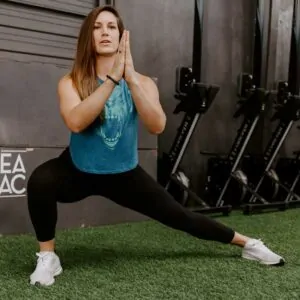Stretching is an area of fitness that many of us are guilty of putting on the backburner (we’ve been there in our early days!); however, stretching is more crucial than you might realize.

Picture this: you’re staying consistent with your strength-training and your cardio, but haven’t been giving yourself enough time for a good warmup or post-workout stretch. You’re starting to realize that even though you’re making gains, you’re sore really often, and you can’t always get into the correct form for some of your heavier workouts.
At best, this cycle causes your performance level to decrease. And at worst, you’re putting yourself at an increased risk of injury.
Fortunately, a regular stretching routine can help.
Your joint health, muscle flexibility, and range of motion are all crucial for your health and fitness, but too many of us skip it in favor of the more exciting parts of our routines. But as you’re working on building your muscle strength, you should also be stretching so that your joints can keep up.
It’s not good to skip stretching even if you don’t hit the gym, either. Sitting for long periods of time can wreak havoc on your muscle and joints, and getting a daily stretch session can help to relieve some of that pain and tension.
So whether you’re hitting the gym regularly or you’re a little more sedentary, here’s how to plan out the best daily stretching routine for you.
Why You Should Be Stretching Every Day
The benefits of stretching every day include:
• Increased range of motion. Stretching can improve your range of motion – in other words, the ability of your joints to move in all the different directions that they should. This can help with your mobility as well as with supporting your muscles during a workout, both of which are important for preventing potential injuries.
• Better flexibility. In addition to better joints, you also want to have increased muscle flexibility both during workouts and in real life. Regular stretching can keep your muscles limber, not tight, so they’re at less risk for tears or sprains.
• Decreases soreness after a workout. Stretching improves circulation, increasing the amount of blood flow that gets to your muscles, which can help your recovery after a heavy workout and minimize that uncomfortable soreness that can come a day or two after.
• Helps with pain. Besides the pain that can come after a workout, stretching can also help with other kinds of pain. For example, chronic back pain could be coming from tight muscles that are underused because you’re sitting or inactive for long periods of time, and stretching can help bring some relief. [*]
All of these things can add up to a better performance in the gym and a less painful existence outside of it.
What A Good Stretching Routine Looks Like
The more you stretch, the better off you’ll be. You can get away with two or three longer stretching routines during the week, but for the best results and overall body health, you should be stretching daily.
The best results would come when your muscles are a little warm – for example, after a workout or a walk – but you can also do plenty of dynamic stretches whenever you get the chance. As a rule of thumb, though, you should always include a stretching session whenever you do get a workout in, so you can work on your flexibility at the same time that you’re working the related muscles.
In addition to stretching frequency, you’ll also want to pay attention to how long you hold each stretch. Focus on holding each static stretch for 60 seconds, or a full minute, for the best results.
And as is the case with anything, don’t push too hard, especially when you’re first starting out with your stretching routine. Most stretches will be a little uncomfortable, but they shouldn’t hurt or bring you to the point of injury. Go slowly and find your limits first so that you don’t hurt yourself, and if you’re really new to stretching, start with shorter bouts until you’re capable of holding them for longer.
How to Build Your Own Daily Stretching Routine
A good daily stretching routine is going to include your entire body, head to toe, for the best results. The major muscle groups you should be focusing on include your neck, shoulders, lower back, legs, and hips. [*] It’s also a good idea to also put a little more focus on the areas that need more love – for example, if you’re going to be doing a heavy leg workout that day, you’ll want to take some time to stretch out your glutes, hamstrings, calves, and hip flexors to improve your range of motion and prevent oncoming soreness.
So a daily stretch routine on a leg day could look something like this:
Neck: Neck rolls
Shoulders: Cross-body shoulder stretches
Lower back: Seated twists
Hip flexors: Lunging stretch and butterfly stretch
Glutes: Pigeon pose and figure-four stretch (lying down)
Hamstrings: Sitting toe reach and lying hamstring reach
Calves: Heel drops off a platform
Remember, you want to hold each static stretch for about sixty seconds, but you can break it up into twenty- or thirty-second intervals if you’d like or as you’re just starting out.
Also, don’t forget to try our Daily Mobility Workouts, which will take you through the BEST stretching and mobility exercises every day! (P.S.: you get a 14-Day FREE trial of the app when you sign up).
Some other things to keep in mind as you’re stretching:
• Avoid “bouncing.” It might be tempting to bounce as you’re pushing yourself in a particularly painful stretch, but it doesn’t help your muscles at all and it could even cause injuries if you’re too forceful. If you can’t reach as far as you’d like in a stretch, take it slow and hold where you can until you’re able to go further.
• Incorporate different kinds of stretching throughout the week. There are two different kinds of stretches: dynamic, which involves movement, and static, where you hold your position for a couple of seconds. [*] Do a little bit of both for the best results – for example, try some dynamic stretches as part of your warmup then do static stretches afterward.
The Bottom Line
Don’t skip your stretching routine, whether you’re working out consistently or not. Regular stretches can bring relief to pain, help you get stronger, and increase your performance when you work out, so hop into a routine and see how you feel!
